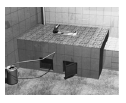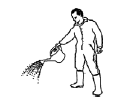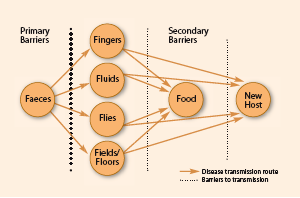Ecological Sanitation
Promoting health and preventing disease 1, 2, 3, 4
The spread of pathogens can be reduced or stopped by using barriers to prevent them moving from one place, such as the ground, to another (fingers, food and/or water. A primary barrier would prevent faeces from reaching fingers, flies, fluids, fields and foods; it would prevent the spread of pathogens. However, if pathogens gain access to fingers, foods and so on, secondary barriers (e.g. washing hands, cooking food) must be relied upon to prevent exposure.
There are a number of options for creating barriers between excreted pathogens and the environment (primary barriers) and thus for preventing the spread of pathogens. The traditional approach is to flush away the excreta (e.g. flush toilet and sewer system) or to store it in a deep pit (e.g. pit latrine).
However, both have limitations with regard to their efficiency in reducing or stopping the spread of pathogens. If the sewage is not adequately treated and made safe before being discharged, this system will only allow to transport the pathogens further downstream. In the case of pit latrines, for example, the contents of the pit may leak into the groundwater or be washed out by heavy rains. And sludge accumulated in pit latrine contains a high amount of pathogens and therefore also represents an important health risk if not adequately handled and treated.









